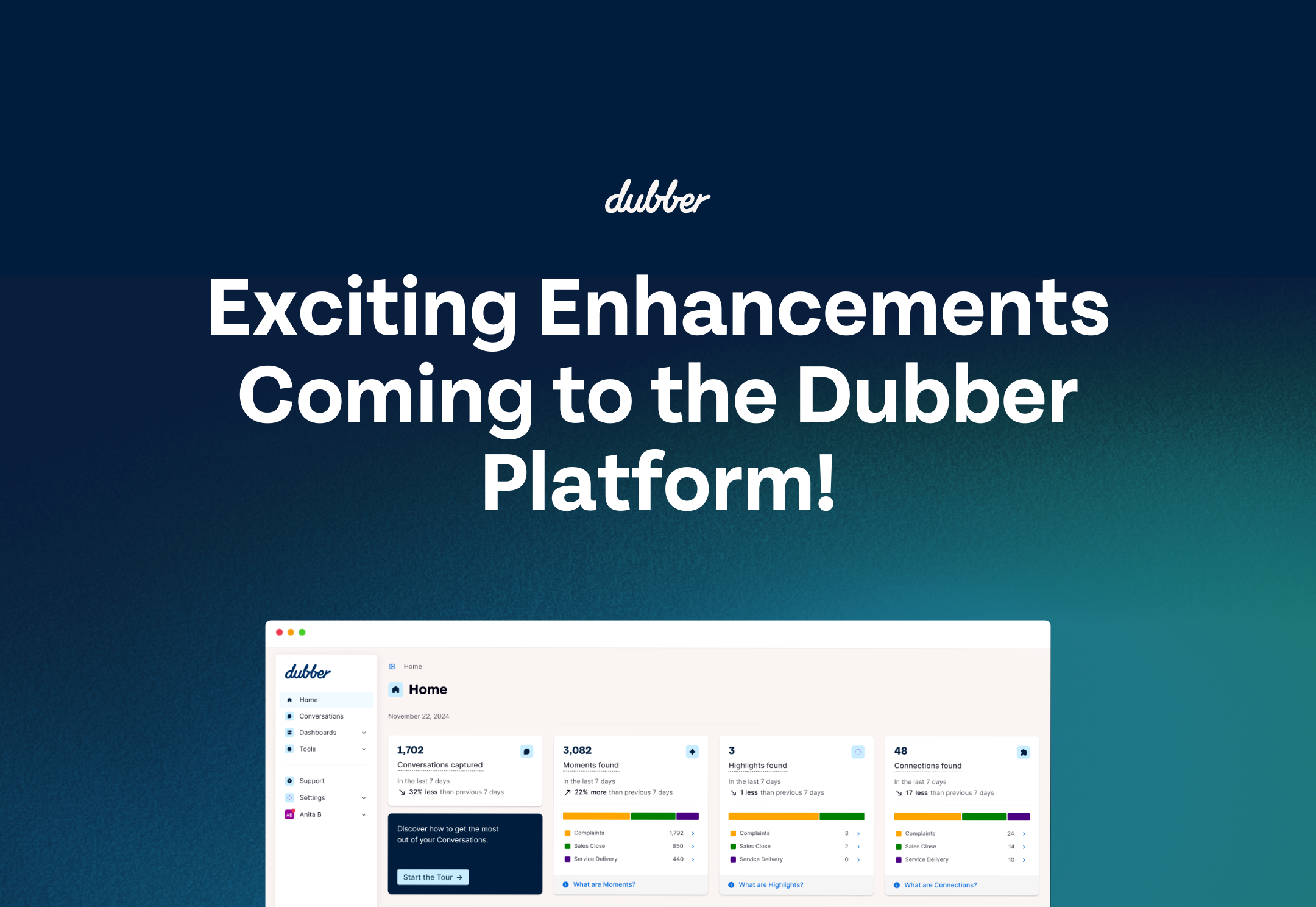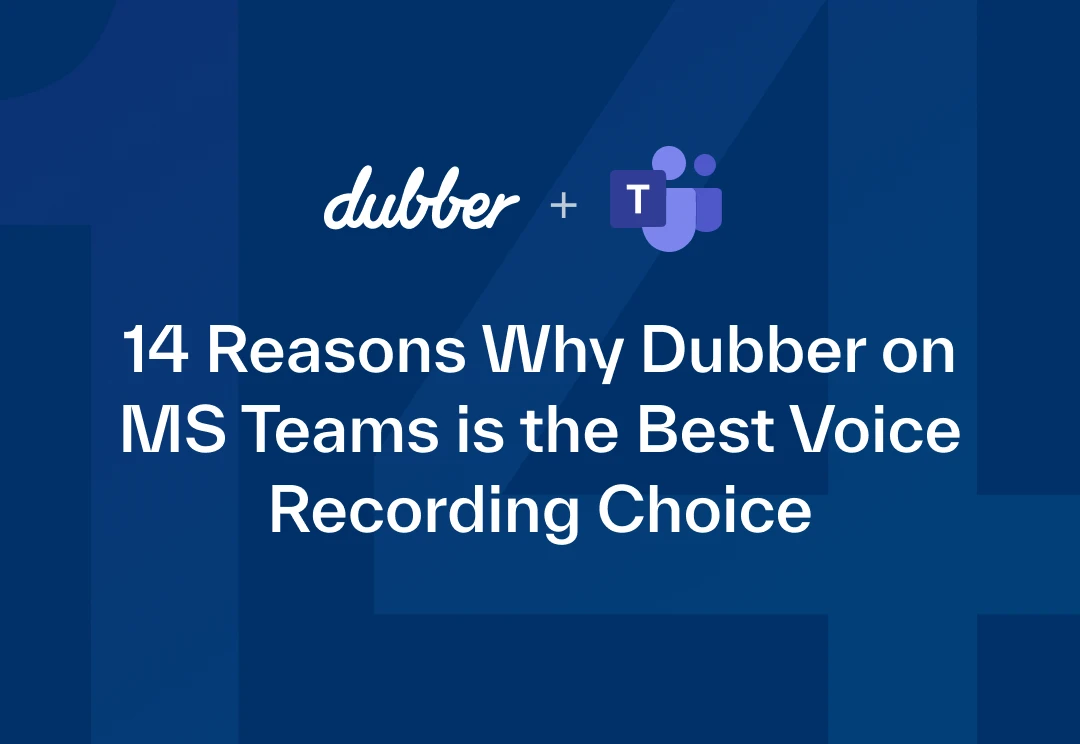
You’ve invested in Microsoft Teams. As a clear Leader in Gartner’s UCaaS Magic Quadrant, your organisation is poised for communications success, and the platform is evolving, meeting your needs and expectations.
But now the search for a recording and conversational intelligence solution that plugs into MS Teams is taking you on a deep-dive into solutions trying to find the right one. Some are just for meetings. Some just do transcription. Most of them come with serious data security concerns.
Here are 14 reasons why the only business-ready choice for Conversational Intelligence and recording on MS Teams is Dubber.
1. Advanced data sovereignty and security
Our solution is secure by design, directly built to conform to global compliance requirements such as GDPR and HIPAA, with best-in-class AES 256 bit encryption, data sovereignty and more.
Download our eBook, How to Ensure compliance on Microsoft Teams for more information, or take a look at our case study; Baseplan ensures compliant comms on Microsoft Teams with Dubber.
2. Total control
Your conversations and their data are yours to configure, replay, organise, and action as you wish. These are accessible by you only – not us.
3. Asynchronous scale, just like MS Teams
Just like MS Teams storage, tenancies, and regional requirements scale without tricky configuration; so too does Dubber.
4. Record with certainly
Dubber is always on, always working on all your required conversations. No more “Sorry, I’m having technical difficulties,” embarrassments and time wasters.
5. Enforceable recordings
Dubber recordings meet legislative requirements for data storage and capture, setting both your CIO and lawyers at ease.
6. Purpose built for UC capture
We’ve purpose-built Dubber so it integrates seamlessly with Unified Communications platforms like MS Teams. No fiddling around with trying to make apps talk to each other.
7. Native and dynamic
Dubber is a live platform. End-users are able to interact with conversational data as it is happening throughout each conversation, plus set triggers and alerts, or peruse historical data and notes.
8. Deploy with a click in minutes
There’s no need for systems admins to walk through complex setups to gain conversational intelligence on Microsoft Teams. Deploy Dubber with a click.
9. Continuous innovation
We follow the rapid release cycle model set by industry leaders such as Microsoft. That means we’re bringing new features to our platform constantly – keep up to speed via our blog and socials.
10. No limit storage
Keep all your records for as long as you like. There’s no limits on storage size or time kept, with Dubber, thanks to the power of cloud.
11. Simple and easy management
Administrators gain significant time back with a solution that doesn’t require constant management. Simply onboard team members to the platform via Azure AD, Microsoft’s identity management service that powers Teams.
12. Real-time search
Search entire organisational conversation banks like you would do Google. Find conversations that match names, topics, dates, and keywords.
13. Advanced AI-powered intelligence
This is where our platform shines, with advanced sentiment and tone analysis, the ability to instantly and automatically trigger workflows and alerts – as conversations happen, and more.
Download our AI litepaper, Unlock intelligence from every conversation with Dubber AI for more details.
14. No hidden costs
Our pricing models are set. There’s no uncertainty when it comes to billing, like when you go over a certain storage limit on some providers.
No other solution on the market ticks all the boxes we do. Chat to us about making the most of MS Teams with Dubber on the conversation.
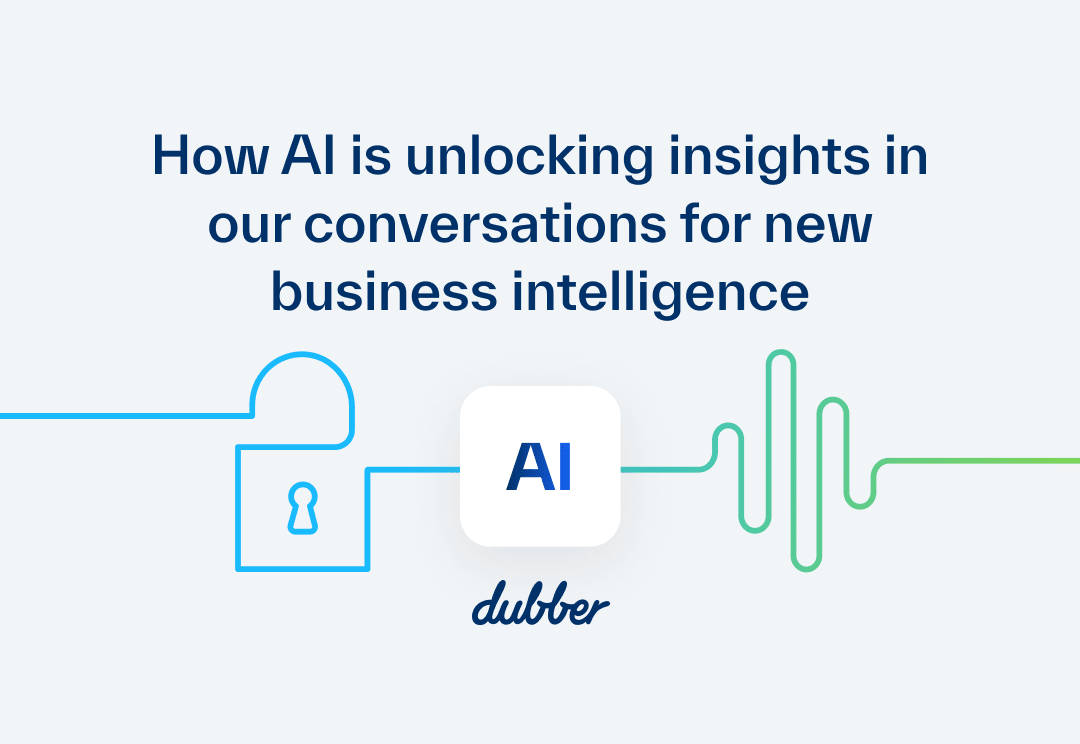
We’re doing AI on business conversations. But what exactly does that mean? How are we going about it? Most importantly – what do organisations and individuals stand to gain from it?
Read our whitepaper, Unlock intelligence from every conversation with Dubber AI.
What is AI?
“Artificial intelligence leverages computers and machines to mimic the problem-solving and decision-making capabilities of the human mind.” – IBM]
Artificial Intelligence is a bit of a catch-all phrase, covering anything a machine can do that ‘feels’ human, processing data and performing actions that a human would. For example, a machine could scan inbound emails for invoices from valid vendors and pay them, just like an assistant would.
But ‘true’ Artificial Intelligence is something deeper.
And that’s when we tend towards Machine Learning.
“A program or system that builds (trains) a predictive model from input data. The system uses the learned model to make useful predictions from new (never-before-seen) data drawn from the same distribution as the one used to train the model.” – Google
Machine Learning is when machines process great reams of data, becoming able to learn from data points what some human-defined object or concept is – and what it is not.
For example, when you go through ReCaptcha activities, clicking on fire hydrants, it’s to check whether a machine came up with the same answers for the hydrants – a machine that’s currently doing Machine Learning. Down the line, this will be applied in your self-driving car, so that it knows to swerve to avoid said hydrant – giving it ‘intelligence’ that seems human.
Since machines have a far greater collective processing speed than the human collective processing speed, it’s allowing us to classify objects or concepts far more quickly than an office of 100 analysts. This is combined with infinite, non-degradable storage – which far outperforms the capabilities of our human memory.
What does AI have to do with business conversations?
You likely already use Business Intelligence tools in your organisational analytics capacity, perhaps pulling financial information into slick dashboards in Power BI. Augmented Analytics is a step further, beyond statistical analysis to integrated machine-learning capabilities within your analytics processes and apps.
“Augmented analytics uses machine learning to automate data preparation, insight discovery, data science, and machine learning model development and insight sharing for a broad range of business users, operational workers and citizen data scientists.” – Gartner
Augmented analytics, with the help of Natural Language Processing, a form of machine learning, is what Dubber does – for business conversations.
…
Consider this: What are the ‘things’ in your business conversations that fall down the cracks? Whether it’s just two people on a phone call, or a boardroom full of people, there will be ‘things’ that are missed.
It’s why we take notes. It’s why we replay key conversations over in our heads. It’s why our most important action items come from a stern tone from a stakeholder.
But, as humans, we’re fallible and we fluctuate in effectiveness. And we’re only as useful as the collective on the conversation.
Putting machine learning to work on our conversations allows us to focus on the importnant things.
With a machine on the call, suddenly, these thought and manual process-consumptive tasks are off-loaded to a large degree to a machine brain that’s far faster at processing, and far better at remembering than our own collective intelligence. Dubber Notiv can automatically create action items for us instead of having to scribble them down.
We still need to think on our feet during the conversation, but we now have access to a post-conversational database and insights we may have missed. It’s a more effective, less error-prone memory bank. It can process and recall all the information in a conversation near-perfectly – and it gets better over time, as is the beauty of machine learning capabilities.
And when you start to combine all the conversations across your business? And being able to have a machine dig into combined insights across these conversations? Well, now you are getting to the crux of your biggest people-based business assets, your new and missed opportunities, your unsurfaced areas of improvement.
It’s Conversational Intelligence. And it’s what we do at Dubber.
Speak to one of our experts about your business needs and leveraging Dubber AI to unlock conversational intelligence, or download our whitepaper Unlock intelligence from every conversation with Dubber AI.
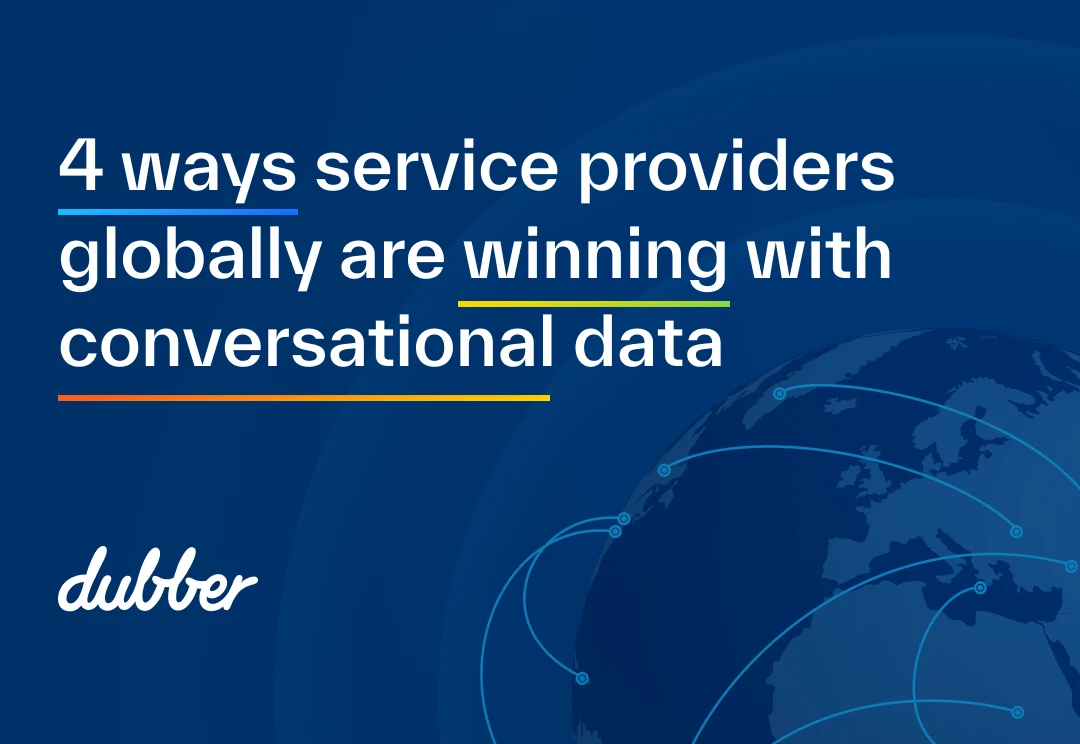
Service and solution providers globally are capturing conversations and monetizing voice connections using unified call recording and AI.
Here are the four ways that they are benefiting.
1. Delivering connections and content
Network-native unified conversational recording and AI can be deployed with minimal cost and deployment effort. It means service providers can quickly provide valuable content and intelligence, such as compliance, customer and people insights to customers.
While bundling is traditionally a calling, internet, and video service package, operators can leverage service/content bundling, together with conversational recording and data insights, to help reduce subscriber churn by up to 50%. (S&P Global Insights)
“Customers worldwide are responding to increased regulatory and compliance obligations for their businesses. Embedding tools, like Dubber call recording, as a standard service that is available to Webex users will help customers meet those requirements while enabling easy access to powerful advanced voice data services.”
– Lorrissa Horton Vice President and General Manager of Webex Calling and Online
2. Accelerated and increased revenue
Service providers are building new and differentiated services with unified call recording and AI that answer customer needs (for compliance, customer and people intelligence) and create a pathway to increased revenue, retention and new customer acquisition.
During COVID-19 recovery, service providers are expected to see new levels of demand across revenue streams in IaaS/SaaS, Cybersecurity, Unified comms, Managed services, and IoT/Industry solutions. (PwC’s Where next for telecommunications?)
“The addition of Dubber into our portfolio has allowed us to unlock new revenue streams in call recording. We share with Dubber a passion to help customers realise the full power of their voice data and achieve compliant communications. The Dubber team provides us with all the support we need to effectively offer this with their Unified Call Recording and Voice AI platform.”
– Paul Harrison Managing Director – Evolve IP
3. AI-Driven Competitive advantage
Service providers are unlocking the power of voice data, AI and NLP as a source of competitive differentiation in every deal and customer account to deliver significant value.
“Dubber has become a crucial partner for Redcentric, we lead with their unified call recording technology but their developments around AI-enriched conversational intelligence really give us the ability to differentiate ourselves and expand the conversation with our customers to add further value.”
– Alex Wilmot, Solutions Director, Redcentric
4. Winning the transition to cloud and work from anywhere
Demand for conversational data has never been stronger, driven by compliance mandates, the need to reduce costs, and a rapidly dispersed workforce working across multiple IP connections.
Growth in unified communications continues to accelerate. Microsoft now has over 280 million monthly active users on Microsoft Teams and over 80 million on Microsoft calling. And UCaaS is following a similar trend with Gartner forecasting it to grow from $46bn in 2020 to $140bn in 2025.
“The collaboration between the M247 and Dubber teams has been excellent. Dubber is changing the field of play when it comes to cloud call recording and conversational intelligence – in-turn this is key value we’re able to provide to our customers.”
– Steve Briant, Head of Enterprise Sales, M247
Moving beyond simply selling connections to monetizing the value of content on the network is a key service provider growth strategy.
Network native conversational recording creates differentiation from day one that only grows as the insights in data are unlocked. Creating a large addressable opportunity from a broad user base creates significant ARR upside. It’s why leading providers from AT&T to Cisco and Telstra are deploying Dubber today.
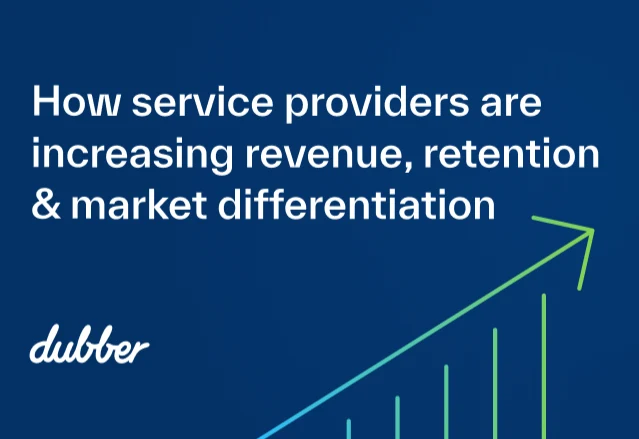
Nearly every Service Provider strategy starts with one or all three.
Service Providers are under pressure. In an environment where sources of value are ever-decreasing and product offering differentiators are slim, increasing revenues is a challenge. 2021, McKinsey suggests, was a critical year for operators: a unique opportunity to fundamentally reimagine their business or, alternatively, risk another decade of decline.
Reimagining the business of operating communications services starts with moving beyond just creating connections to realizing value from the content flowing on the network. Central to achieving this outcome is Unified Conversational Recording (UCR) – through which every conversation is captured for replay, converted to data, and enriched with AI for insights and intelligence.
Demand for conversational recording is unprecedented with Gartner indicating that by 2025, 75% of conversations at work will be recorded and analyzed, enabling the discovery of added organizational value or risk. This is a substantial market opportunity for service providers who already provide the network infrastructure for these conversations.
Embedding conversational recording and intelligence that adds value to existing customers at minimal cost and low configuration complexity is the ideal way to target this trend.
A Unified Conversational Recording solution drives revenue for service providers-
- A typical network legacy call recording solution represents a significant cost – in the millions of dollars to provision, manage and provide ongoing services. A UCR solution is a fraction of this cost, providing immediate yield. Cloud-native call recording services are up to 10X more cost-effective on a per user per month basis. UCR lives in the network and is delivered just as any service would be by the service provider.
- By switching a UCR solution on for every end-point, service providers create an immediately addressable market to sell richer solutions addressing continually rising customer needs.
- UCR solutions allow service providers to enjoy the benefits of SaaS ARR, with pricing models built in line with modern subscription market trends.
What is UCR in a S&SP Network?
UCR is:
- Native to the service provider network: to remove legacy recording costs, and allowing UCR to be delivered as a service
- Cloud-first: for simple deployment, management and provisioning
- On every endpoint: creating immediate differentiation and an addressable market for fully featured solutions
- SaaS ARR: creating a new recurring revenue stream
- True AI: for the ability to unlock conversational insights and solutions revenue
Foundation Partners Benefit More
The Dubber Foundation Partner program was designed to provide service providers with deep marketing, sales and success support – accelerating the conversion of basic Dubber call recording services to richer solutions.
- 100% attach at day one drives differentiation and immediate access to upsell opportunity
- Dubber assisted upsell to SaaS plans – increasing ARPU, in many cases doubling the ARR per customer
- Add & unify other services – further increasing ARPU through cross-sell and access to other communications services used by the customer
- Unlock the potential of conversational data to increase revenue and retention

Expensive, outdated legacy call recording’s days are numbered. And, as a communications providing service, you can capitalise on a new market that’s emerged from an overhaul in antiquated infrastructure.
Up until now, organisations have required significant investment into managed, onsite call recording equipment.
The costs multiply due to dedicated storage and processing hardware, complex high maintenance software, and ongoing service and support. And this service only captures just one line or endpoint – with multiple lines or endpoints needing recording, the process (and costs) starts again.
Unified Call Recording in the Cloud
“Unified call recording solutions offer service providers one area where they can really add value. By uniting voice data from an organisation’s potentially disparate systems, a service provider can ensure that an end customer organisation can leverage maximum value from its data and drive enhancements and optimisation.” – Cavell Group
Unified Call Recording in the Cloud replaces legacy call recording with simple to manage, easy to deploy, cloud-based and on-network infrastructure.
UCR is native to the network and requires zero hardware, complex software or heavy ongoing service and support costs. It’s a modern solution for a modern business communications landscape; across mobile, unified communications platforms, chat, and video – and it satisfies legislative compliance and data security requirements.
UCR is the key to unlocking new revenue and retention opportunities in call recording – and product offering differentiation – and enables you to create and add value to every conversation on your network.
Costs tend towards spare change
Now, the cost of voice-supplementary services is tending towards spare change.
In legacy call recording models, the costs associated with extra data services were also prohibitive; including services like manual transcription, sentiment analysis, fraud detection, and other auditing capabilities.
Only the largest enterprises were able to invest to leverage the true power of customer voice data. Now, with cloud-based services that leverage AI radically reducing direct and indirect management and configuration costs, everyone can enjoy call recording, automatic transcription, and conversational data intelligence. Every conversation can be captured and transformed with AI.
Service providers to embrace new services
Service providers who embrace cloud-based UCR voice-supplementary services can now offer these benefits to businesses across all sizes and verticals.
Service providers who adopt intelligent data visibility and usage platforms can increase their revenue and margin generation while increasing their customer’s dependency on their services. With a need to differentiate in a competitive market, it’s by productising and partnering in new connectivity data and content verticals that service providers will set themselves apart.
Source: Cavell Group
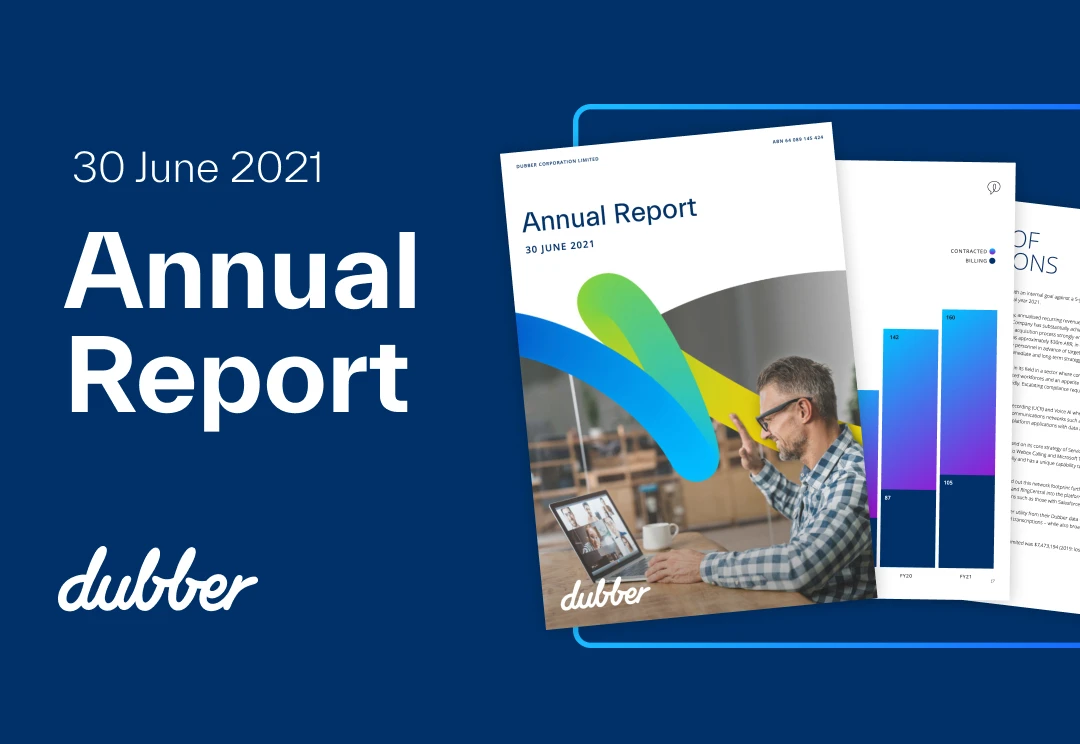
Dubber Corporation Limited (ASX: DUB) (‘Dubber’ or ‘the Company’), the leading global Unified Call Recording & Voice Intelligence cloud service designed for service providers, government, and businesses of any size, today released its Annual Report to shareholders for the year ending 30 June 2021.
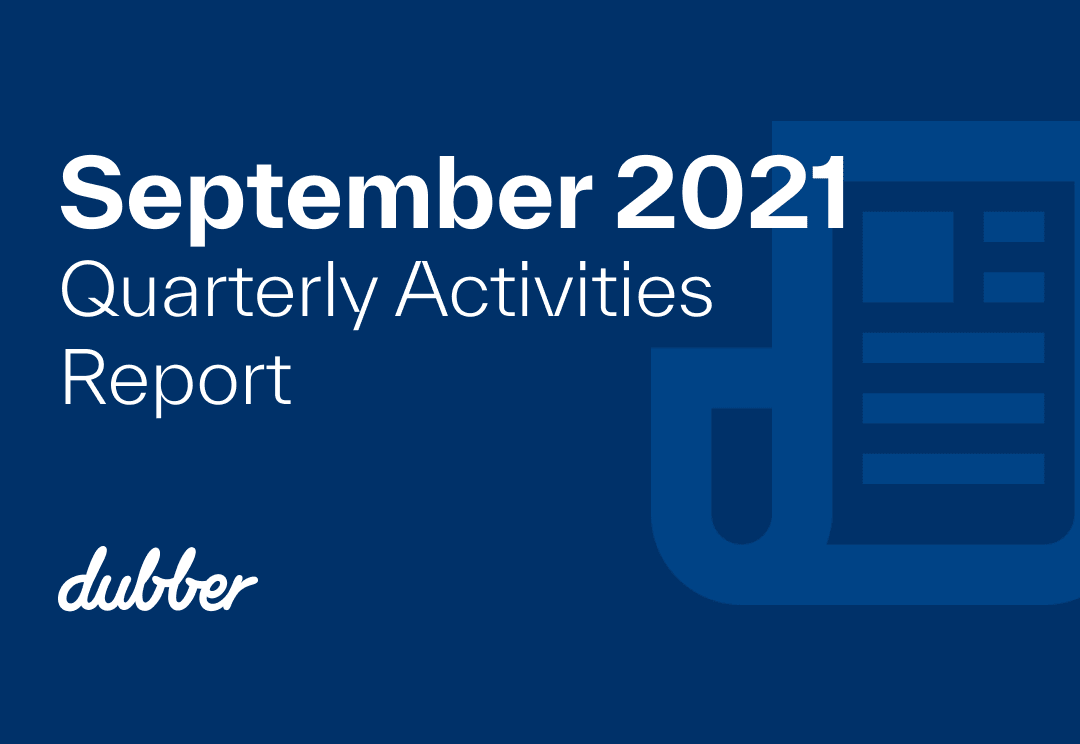
Dubber Corporation Limited (ASX: DUB) (‘Dubber’ or ‘the Company’), the leading global Unified Call Recording & Voice Intelligence cloud service designed for service providers, government, and businesses of any size, today released an update on the Company’s operating focus along with the Appendix 4C for the quarter ended 30 September 2021.

Are you really listening to your customers? Because if you aren’t capturing and unifying the conversations you have with them, meaningful insights are lost.
Sales are a multi-touchpoint experience – voice, video and chat – even more so in this new world. So, how do sales managers uncover hidden revenue?
With total visibility across multiple communication points, a centralised platform, and a little help from AI.
Traditional solutions where the recording is attached to an app or a single connection point limits visibility, introduces complexity and increases cost – inevitably you end up paying for multiple conversational recording solutions.
According to Gartner’s top strategic IT predictions for 2021 and beyond, by 2025 75% of conversations at work will be recorded and analysed. Many of our clients are in tune with these predictions.
Get acquainted with Dubber’s Six ways to improve your sales with Voice Intelligence for a more in-depth look at how you and your team can establish a whole system of continual sales revenue. Dubber’s UCR and AI conversational intelligence supports compliance regulations whilst assisting businesses in enhancing their sales revenue by unlocking insights in calls, video and messages.
Tone and sentiment analysis for opportunities and performance
Having the tone and sentiment analysed from your customers is fundamental in distinguishing who is:
- A prospective customer
- A customer that could be upsold
- An undecided customer
- Not interested
Identifying positive or negative interactions or prospective customers from the sentiment analysis lets you customise your sales pitch to meet specific needs to boost sales.
Tone analysis is a distinct advantage to your sales growth. It helps sales reps execute a consistent and compliant delivery – boosting satisfaction and customer experience, which increases the chances of consumers making another purchase by 89% *.
Forecast and generate more reports
Dubber’s contact centre intelligence looks at all the call activities with powerful analytics- ensuring sales managers can see key metrics at a glance. The dashboard provides a high-level snapshot of call metrics and data analytic solutions for managers to monitor agent performance. These insights include:
- Automate the agent QA process through score sheets
- Train sales and customer teams to implement better solutions
- Set-up out-of-the-box or custom reports (schedulable)
- Access an in-depth activity log for all user initiated activities
Dubber’s reporting tools help improve workplace performance and proactively manage risks – enabling sales managers to learn which products need more consideration or which employees might need additional support on meeting sales targets. Attending this detail allows managers to predict forecasts and achieve better solutions based on analytical insights.
Leverage transcripts for retargeting and retention
With live transcripts from customer conversations, you can keep track of customers’ requests, interests, and expectations. Dubber’s beautiful and insightful transcriptions provide a powerful source of information that can enlighten a staff member or manager on a missed sales opportunity.
For example– a manager reads the transcript of a conversation to a customer. By identifying communication gaps, the manager can recognise the customer is left unsatisfied. Then, using notes from the transcript, they can reach out to the customer and suggest a more suitable alternative, capturing the sale after all. Critically they have an accurate record of the nuances of the conversation to coach and train. Hearsay gets replaced with “knowsay”.
A record of notes and highlights from past conversations helps managers:
- Retarget prospective customers
- Action insights from conversations
- Decrease revenue leakage with immutable proof
- Navigate a system of churn reduction
- Improve training and coaching
Improve order and service accuracy
With real-time transcripts, managers can be confident that information and customer instructions are captured accurately. Dubber’s search filter enables mishaps and miscommunication to come to light.
Disputes are likely to arise based on mistaken orders or inaccurate quotes- stay ahead of this by searching keywords, customers, or employees to find a resolution based on facts from the conversation- not hearsay.
Sales managers use this function to find revenue leakage by examining conversations and seeking ways to improve the sale. Based on these key findings, managers can implement a strategy that outlines procedures to strictly use or to avoid – saving time and retention.
Measure performance on specific keywords or phrases
Managers can set certain spoken words to trigger a notification alerting them of said words within a sales conversation. For example, these words, phrases or trends may be: “New”, “Expire”, “Plan”, “Renew” or “Cheapest.”
These words indicate a particular end of the subscription period, like a plan. So here is an opportunity that managers seek out as it gives them the chance to upsell, cross-sell, or put them on a new plan that’s promoted to reach the sales target. This also allows sales managers to foresee trends occurring and optimise the collected data to engage in a higher sales success rate.
Contribute key findings to marketing
By using Conversational Intelligence, sales managers can determine any gaps in the market and then transfer that data and insight to the marketing teams.
The symbiotic relationship between sales and marketing creates a vital role — they can influence or help shape how the product is understood:
- Positioned in the market (in relation to competitors)
- Identify who are the most common consumers
- If a product/service is resonating with the target market
These insights can help the marketing team build a more in-depth buyer persona and give future marketing strategies a more direct and consequential message.
Discovering hidden revenue opportunities from recorded conversations authorises sales managers to turn key findings into actions, successfully increasing revenue. Dubber’s features enable sales managers to drive actionable insights from the business’s two most important resources: employees and customers.
*Salesforce

The landscape for technology services is evolving, more rapidly than ever before. External environmental factors, including the COVID crisis, have accelerated the evolution of enterprise technology requirements and, in turn, transformed demand for innovative and differentiated solutions from service providers.
Communications service providers face a highly competitive market, with new digitally disruptive and emergent companies, thin-margined pricing strategies, and exponentially exploding user demand and expectations.
The need to differentiate – new roles for service providers in the enterprise connectivity market
Now, more than ever, service providers need to stand out and offer unique differentiated solutions to remain relevant. And that needs to be through a best-in-class multi-vendor, multi-solution suite of services – that provide communication and collaboration services. The UCaaS landscape is the ideal playground for the savvy enterprise-focused service provider.
It’s time we go beyond traditional operating models; to shift roles from simple Connectivity Providers to Service Enablers and Service Creators. Out to 2030, there is up to USD 700 billion in B2B value at play in these new role markets, and that’s just across 5G opportunities alone.
This new way of doing business allows service providers to think like cloud providers and productise critical, emergent communications services on their networks. And, like cloud providers, these services need to be enabled to customers with a click, and provide a self-service interface.
Could customer experience be a critical product offering win?
Qualtrics ROI of Customer Experience 2020 report showed that 94% of customers would purchase more from a company with very good customer experience (CX), as well as recommend them to others, resulting in increased revenue and reputation building. As a service provider, being able to offer enterprise customers a CX product that’s ready to go, no matter their communications infrastructure is a clear, easy win.
A principal strategy: adding embedded Conversational Intelligence as a Service to the list of products available for businesses, yes, switched on with a click. It’s customer experience, reimagined with the power of data – by Dubber.
Learn more about how new productization is key to service providers winning in a crowded market where margins are slim. Download the Cavell Group whitepaper, commissioned by Dubber, “Service provider differentiation through customer experience.”
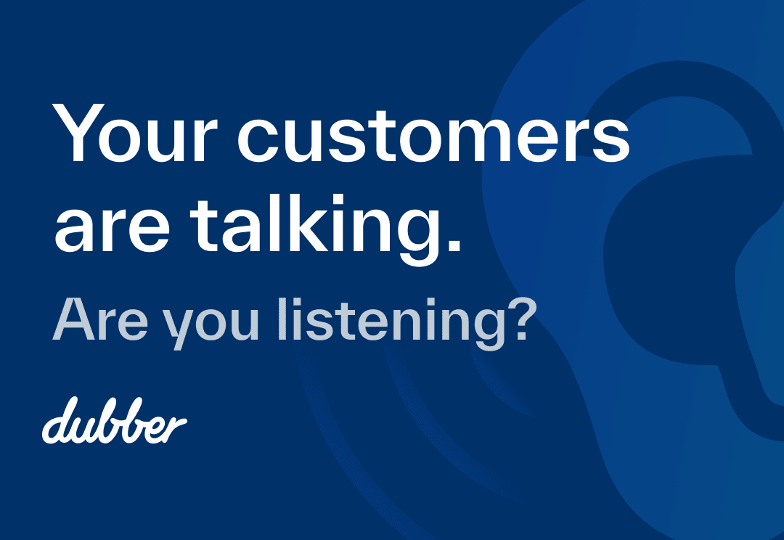
A wealth of data is locked in the conversations your business is having with customers. Conversational intelligence is the key to unlocking that wealth so you can differentiate your business in the market, boost revenue and retain customers.
Chances are, you already listen to your customers.
You do if you use call recording for compliance or training purposes.
That means you are capturing valuable insights into business performance.
Listening to what customers say is the best way to understand what they want. Pay close attention and you will know what they think and how they might respond to offers. You will understand them better.
It’s important to hear both the words and the music in a conversation. That is, the tone, the hesitations and other non-word clues.
Do that and you’ll pick up crucial insights you won’t find in other forms of communication.
Until now this has been hard to do.
Face-to-face listening is hard to scale. Team members dealing with incoming calls tend to focus on specifics. That’s how they are trained and it is how they are rewarded.
Any intelligence gathering done the manual way is, at best, secondary.
Now, thanks to Dubber cloud-based call recording, you can listen and understand what your customers are saying. Cloud based recording means you can capture every spoken word. You can collect both the words and the music of business conversations at scale.
There’s something certain about an audio recording of a conversation. Other records, either a written note or a reported conversation are only hearsay. They can’t be substantiated. In a strict legal sense they are little more than rumour. There’s always a degree of uncertainty. With an audio recording, or a written transcript of an audio recording you are dealing with verifiable information.
What’s more, when you capture a conversation by making notes, you are not listening closely enough to what is being said. Your brain is in a translating, transcribing mode. It’s controlling your pen or your figures on a keyboard.
When everything is recorded in the background you can focus on listening.
Better still, the technology means you can automate the listening.
AI, sentiment analysis and other techniques can pay close attention to every moment of every conversation.
Say there’s a barely audible wince when your team member mentions price to the customer. Or a gasp when new product features are described. They are powerful signals that team members might overlook — the software doesn’t miss a beat.
It means for the first time you can know what customers actually think.
You can better understand customers and their needs.
This gives you the power to differentiate your business.
You’ll get better customer satisfaction.
AI tools can warn that a customer is thinking of going elsewhere. You’ll have time to move in early to avoid losing their business.
None of this requires dramatic change to your business process. It uses tools you have at your disposal.
Now is the time to act.
Gartner says by 2025 companies will record three quarters of business conversations.
Voice is the most common communications channel between a business and its customers. Around four out of five customer interactions are voice conversations.
Once you are recording all your calls, it’s a short step to mining them for customer intelligence.
The best way to do this is with cloud call recording. In the past companies installed on premise call recording systems. They linked them to centralised call centres.
That’s useful, but centralised call centres only capture half of all customer conversations. Many businesses have found accessing and mining calls from legacy systems difficult and slow.
These days the interactions that matter take place elsewhere. Remote work teams and mobile employees mean people can take calls anywhere.
That’s why capturing voice data at the network level is vital. A cloud call recording system with instant easy access to conversations like Dubber does this for you.

